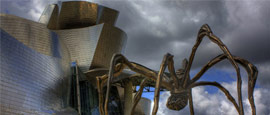Founded in 1908, the Fine Arts Museum Bilbao features an extraordinary variety of artworks from the 12th century to the present. The collection includes more than 6,000 works of art, from paintings, sculptures and drawings to engravings and decorative objects. It is divided into three parts: one for classic European art, with works by artists like El Greco, Murillo, Goya and van Dyck; the second for contemporary art, including works by Gauguin, Bacon, Chillida and Barceló; and the third for Basque art, showing works by Regoyos, Zuloaga, Echevarría, Iturrino and Arteta among others.
Things to see in Bilbao
Tourist offices
Address: 1 Plaza Circular, Bilbao, Vizcaya, 48009, Spain
Tel: +34 94 479 5760.
Opening Hours:
Daily 0900–2100.
www.bilbao.net/bilbaoturismoBilbao Turismo also has an office at the Guggenheim Museum.
Bilbao's greatest tourist attraction is without doubt the Guggenheim Museum. Designed by architect Frank Gehry, it is a vast titanium-clad structure in the centre of Bilbao and has 11,000 sq m (118,403 sq ft) of exhibition space distributed amongst 19 galleries. It features the works of some of the most influential artists of the later half of the 20th century including Picasso, Motherwell, Rauschenberg, Still, Tàpies, Warhol, Klein and de Koonig.
Bilbao's Old Town is known as Las Siete Calles (the Seven Streets) because that’s how many cobbled walkways it was originally centred on within the ancient city walls. Since the 19th Century, though, it's expanded northwards towards Plaza Nueva. This is the part of town where visitors usually spend most of their time, either checking out the historic churches, the cathedral and the atmospheric little squares, or joining the tavern-crawling choral societies indulging in Bilbao's great passions: eating pintxos (tapas on sticks) drinking wine and singing.
Bilbao's oldest church was originally just a stop on the pilgrimage trail to Santiago de Compostela in the west. It was started in 1379 and finally finished in an impressively ornate, Gothic style in 1643. As well as the eponymous St James (or Santiago in Spanish) the church also honours the local devotion to commerce, with the effigies of respected merchants carved into the main vault. It became a cathedral in 1950.
Until 2010, the Alhóndiga was an elegant but crumbling, 19th century wine warehouse. This was before it was handed over to French designer Phillipe Starck who did a magnificent job in turning it into the spectacular arts centre it is today. There are curvaceous, extravagantly decorated pillars, illuminated benches and, most impressively, a glass-bottomed swimming pool three storeys above the vast lobby.
This Bilbao museum is well worth a visit. It features exhibits from the Basque region's prehistory, archaeology, ethnography and history. The permanent collection allows visitors to explore topics such as the prehistoric Biscay area and the maritime world in the region as well as fishing and trade, pastoral life, handicraft textiles, pottery, weapons and furniture.
Considered to be among the most significant contemporary architectural works made by Spanish architects, Euskalduna Palace was designed by Federico Soriano and Dolores Palacios and represents the last ship built in the old Euskalduna shipyard. A symbolic representation of Bilbao's industrial heritage, this huge multifunctional complex, built in 1999 and located in the city centre, holds a renowned conference centre and a magnificent auditorium. There are guided tours every Saturday at noon.
Bilbao sits at the bottom of a valley, which is good news if you want to get some exercise walking up the steep hills in every direction. However, for anybody less keen on stretching their legs, this light railway provides a charming way to climb the steep slope to the top of Mount Arxanda. Built in 1915 by a Swiss company it travels at a rumbling 5 metres per second and carries 70 passengers at a time.
Few things symbolise modern Bilbao better than the Parque Etxebarria. Once the site of a steel mill, its redevelopment in mid-1980s proved a peek of what was to come for the port when it was turned into the city's most popular green space. Its views look out over the Old Town, while the original tall chimney stack has been left as a monument and a reminder of how Bilbao used to be.
Situated in the docks of the old Euskalduna shipyard in Abandoibarra, Bilbao Maritime Museum is dedicated to all things relating to the sea and navigation. The indoor section includes exhibitions, a media archive, an auditorium, a shop and a café. Outside, guests can visit the Euskalduna Shipyards, where they’ll find the pump house once used to drain the docks and the bright red, 60m (197ft) high Carola crane, which has become a symbol of the reconstruction of the city.
Do you have any Feedback about this page?
© 2025 Columbus Travel Media Ltd. All rights reserved. No part of this site may be reproduced without our written permission, click here for information on Columbus Content Solutions.








 You know where
You know where